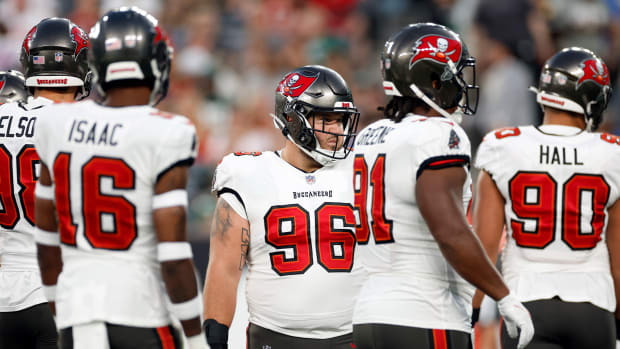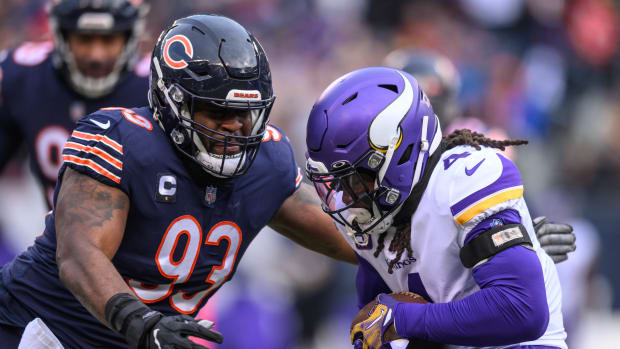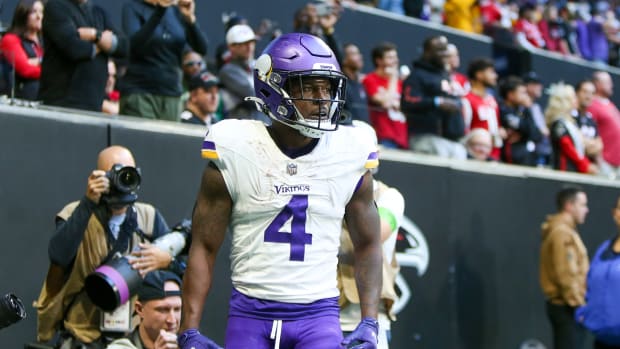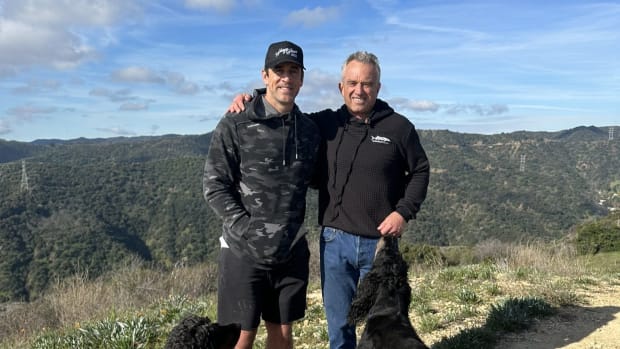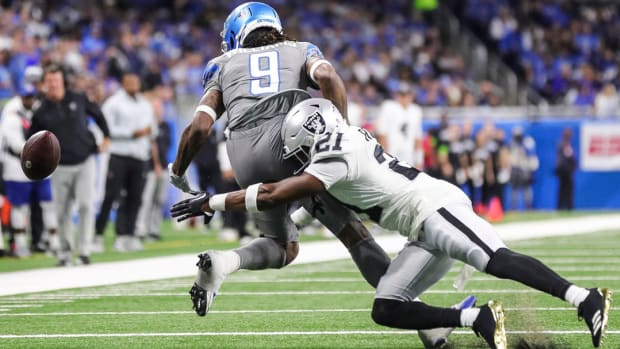SI 50, Nos. 38–36: Chris Jones, Cody Whitehair, Eli Apple
Get all of Doug Farrar’s columns as soon as they’re published. Download the new Sports Illustrated app (iOS or Android) and personalize your experience by following your favorite teams and SI writers.
With free agency winding down, and the 2016 NFL draft fast approaching, it’s time for all 32 NFL teams to finish the process of getting their draft boards in order and ranking players based on their own preferences. At SI, it’s time for us to do that as well. To that end, Doug Farrar has assembled his own Big Board, with his top 50 players.
• Counting down SI.com’s top 50 prospects: 50–48 | 47–45 | 44–42 | 41–39
The SI 50 uses tape study to define the best prospects in this class, and why they’re slotted as such. The next trio of players includes a developing defensive lineman with the ability to play every gap, the best guard prospect in this draft class and a big-school cornerback with all the tools to succeed as a starter... if he can keep his hands to himself.
38. Chris Jones, DT, Mississippi State
Height: 6' 6" Weight: 310 pounds
Bio: Gap versatility is the keystone for the modern defensive lineman, and Jones fits that mold perfectly—per Pro Football Focus, he played tackle for most of his 609 snaps last season, but he also played 68 snaps at nose tackle and 73 snaps at end. Moreover, he did it all at a high level, amassing 36 tackles, seven tackles for loss and 2.5 sacks in 2015. This was his first season as a starter after two years as a rotational player, but he’s always had an effect on the Bulldogs’ front four.
“I watch Trent Cole or Fletcher Cox and J.J. Watt, Ndamukong Suh, all those types of guys. I feel I model my game after those guys. Those guys later in life are going to be Hall of Famers. J.J. Watt has won three defensive MVPs. Fletcher Cox, a dominant defensive lineman for the Eagles. Ndamukong Suh, a dominant defensive lineman in the NFL. All those guys have something in common. They’re going to be Hall of Famers. I try to model my game after them.”
Jones isn’t quite at that level just yet, but he’s developed his game over the last three years, and the best may be yet to come.
How can nation’s leading WR still be an NFL draft afterthought?
Strengths: Jones plays with tremendous natural power off the snap. Knows how to use forward momentum to crash into blocks, and frequently requires chips and double-teams from multiple positions. Can line up credibly everywhere from one-tech to end. Has a determined playing personality at the start of a play—will persistently and consistently push blockers back and move assertively through slide protection. Has the athleticism to pursue from sideline to sideline and is a dynamic wrap tackler when he gets to the ballcarrier. Uses his feet to feign and move well to get past and through blocks. Keeps his shoulders square to the target and isn’t easily fooled by more elusive players. Tough-minded player with a good work ethic.
Weaknesses: Very tall player who needs to be more aware of pad level and leverage—when he comes off the snap too high, Jones can get wiped out of a play. Must use knee-bend to generate more play-to-play power. Would like to see him go all-out through the whistle; there are times when he seems to stop before things are done. Leans into multiple blockers more than he rips or swims out of conflict—needs more and better hand moves to disrupt. Needs a more diverse pass-rushing repertoire.
Conclusion: Jones’s games has continued to develop through high school and college. He may have benefited from another season in college, but there’s a high possibility that a ton of NFL teams will see him as a late-first/early second-round prospect. Jones played in a four-man front in college, but he projects well in a 3–4 or hybrid base scheme, as well. When you combine his gap versatility with his raw physical tools, it’s clear that Jones is still on the ascent.
Pro Comparison: Ra’Shede Hageman, Falcons (second round, 2014, Minnesota)
• KLEMKO: Scouts open up about prospects with off-field red flags
37. Cody Whitehair, OG, Kansas State
Height: 6' 4" Weight: 301 pounds
Bio: Whitehair is a rare entity—a draft prospect that is both eminently versatile and very safe. A 50-game starter who played both tackle and guard for the Wildcats, he’ll come into the league as a virtual sure-thing guard prospect, though he’s not yet ready to give up the dream of playing outside. He said at the scouting combine that he’ll play wherever his NFL team wants him to, and if that team wants to move him to center, he can probably do that, too. It’s tough to doubt him too much. Whitehair has made the most of his football opportunities, and turned himself into a weight-room monster who makes it all work on the field.
When asked at the combine how he’d deal with NFL defensive tackles as a guard, Whitehair made it sound very simple. “I think I would jump-set those guys, really get my hands on them and knock them down.”
As they say, it ain’t bragging if you can back it up. And as a power guard, Whitehair can do all that and more.
Notes from Michigan State's pro day: Connor Cook, Jack Conklin, more
Strengths: Technical mauler with all the right attributes for blocking in a short area. Gets his hands on the opponent immediately off the snap and pushes back with a nasty disposition and tremendous upper-body strength. Gets to the second level quickly and locks on targets with accuracy. Seals the edge on run-blocks as well as anyone in this class. Great punch and power for a player who spent a lot of his collegiate career in a two-point stance. Gets snapped back at times, but recovers very nicely and battles throughout the play. Uses his upper body and momentum to push defenders several yards back at times. Keeps his head on a swivel in zone protection and adjusts well against twists and stunts. Ferocious work in the weight room absolutely shows on the field.
Weaknesses: Whitehair’s projected move to guard in NFL is based on arm length (32 3/8"), and the lack of a consistent kick-slide to deal with edge-rushers. More powerful than fluid and can be downright clunky at times when backing up in pass protection. He’s great in a straight line, but doesn’t always show up as tremendously agile, and he tends to wander in space at times. Has to let defenders into his area more than he’s able to extend his arms and keep them at bay. Might be limited to guard overall—right tackle at the NFL level seems like a bit of a projection.
Conclusion: Whitehair’s NFL team will have a couple of options with him: either make him into a decent takle, or bend to the obvious—move him inside, and watch him pummel the hell out of opponents for the next 10 years. Zack Martin turned into an All-Pro guard after playing left tackle at Notre Dame, and it was the sensible move to make. Whitehair’s story should be similar—when all he has to do is line up in a three-point stance in that phone booth and fire away, the results should be outstanding—and worthy of first-round consideration.
Pro Comparison: Zack Martin, Cowboys (first round, 2014, Notre Dame)
36. Eli Apple, CB, Ohio State
Height: 6' 1" Weight: 199 pounds
Bio: Apple first hit the collegiate scene as a redshirt freshman for the 2014 national champion Buckeyes and has established himself as one of the better pass defenders in this draft class. Apple totaled 86 tackles, four interceptions and 17 passes defensed in his two seasons with Ohio State, overcoming an earlier iron deficiency that sapped his strength. Apple ended his first season with a bang, picking off Marcus Mariota’s last collegiate pass in the Buckeyes’ BCS Championship win over Oregon. He followed that up with a 2015 campaign that saw him named Second Team All-Big Ten. He’s one of the most prized prospects in a packed Ohio State draft class, adding to his draft collateral with a 4.4 40-yard dash run at the combine.
As for his playing style, Apple is well aware that he fits the prototype of the modern NFL cornerback—big, aggressive, and unafraid of contact.
“Just my press man cover skills,” he said in Indianapolis, when asked what about his game transferred to the next level. “That’s something in the NFL that’s really important, to be a physical guy at the line of scrimmage and be able to take receivers off their path. And that’s something I do better than anybody, in my opinion. My press technique is to me better than anybody out there. That’s the main thing I do. I’m a physical guy, and I get up on receivers and impact that.”
No question, and it’s what will make Apple a high pick, despite some obvious technical and in-game fixes that need to happen.
The Case For ... drafting Stanford QB Kevin Hogan higher
Strengths: Good-sized, natural disruptor who lives to play press coverage and contend throughout a route. Does a very good job of establishing inside position on boundary routes and taking the correct angles downfield. Has the awareness to out-maneuver receivers and keep them uncomfortable throughout a route, forcing them to adjust. Willing and aggressive tackler in run support, and can throw off receiver blocks to stick his nose in. Quick enough to trail speed receivers all over the field. Closes quickly on slants, digs and comebacks. Attacks the ball at the catch point—he believes the ball is his on every play. Developed a good sense of the field when playing bail coverage. Has learned to use his hands to keep position on downfield receivers while turning his head to diagnose the cornerback. Has a ton of potential as a pure technician.
Weaknesses: Apple can be too aggressive at times, leading to blown tackles and missed assignments. Spends far too much time getting handsy when he’s beaten. Not a natural diagnostician downfield against receivers running more complex routes. Can be outsized as a cover man and as a tackler. Gets away with short- and intermediate-area muggings in college that will probably get him flagged more readily in the NFL. Needs refinement work as an off-coverage player and potential slot defender.
Conclusion: The NFL has made it very clear—in the modern era, teams will accept over-aggressiveness as the inevitable result of a preferred playing style. There have been a host of such cornerbacks who have come into the NFL in recent years, with their coaches trying to help them walk the line between efficient aggression, and the kind of hatchet work that draws penalties and leads to blown coverages. Apple straddles that line a bit too often, but he’s got enough on the ball to become a formidable prospect, and a potential upscale NFL starter at the position.
Pro Comparison: Trae Waynes, Vikings (first round, 2015, Michigan State)
































